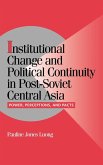Democracy and Authoritarianism in the Post-Communist World
Herausgeber: Bunce, Valerie; Stoner-Weiss, Kathryn; McFaul, Michael A.
Democracy and Authoritarianism in the Post-Communist World
Herausgeber: Bunce, Valerie; Stoner-Weiss, Kathryn; McFaul, Michael A.
- Gebundenes Buch
- Merkliste
- Auf die Merkliste
- Bewerten Bewerten
- Teilen
- Produkt teilen
- Produkterinnerung
- Produkterinnerung
Examines in depth three waves of democratic change that took place in eleven different former Communist nations.
Andere Kunden interessierten sich auch für
![The Cambridge Companion to Marx The Cambridge Companion to Marx]() The Cambridge Companion to Marx84,99 €
The Cambridge Companion to Marx84,99 €![Redefining the State Redefining the State]() Nicolas SpulberRedefining the State71,99 €
Nicolas SpulberRedefining the State71,99 €![The Good Communist The Good Communist]() Frank N. PiekeThe Good Communist22,99 €
Frank N. PiekeThe Good Communist22,99 €![Marxism and Social Democracy Marxism and Social Democracy]() Henry Tudor / J. M. Tudor (eds.)Marxism and Social Democracy132,99 €
Henry Tudor / J. M. Tudor (eds.)Marxism and Social Democracy132,99 €![Institutional Change and Political Continuity in Post-Soviet Central Asia Institutional Change and Political Continuity in Post-Soviet Central Asia]() Pauline Jones LuongInstitutional Change and Political Continuity in Post-Soviet Central Asia100,99 €
Pauline Jones LuongInstitutional Change and Political Continuity in Post-Soviet Central Asia100,99 €![The Good Communist The Good Communist]() Frank N. PiekeThe Good Communist108,99 €
Frank N. PiekeThe Good Communist108,99 €![Dictatorship, State Planning, and Social Theory in the German Democratic Republic Dictatorship, State Planning, and Social Theory in the German Democratic Republic]() Peter C. CaldwellDictatorship, State Planning, and Social Theory in the German Democratic Republic103,99 €
Peter C. CaldwellDictatorship, State Planning, and Social Theory in the German Democratic Republic103,99 €-
-
-
Examines in depth three waves of democratic change that took place in eleven different former Communist nations.
Hinweis: Dieser Artikel kann nur an eine deutsche Lieferadresse ausgeliefert werden.
Hinweis: Dieser Artikel kann nur an eine deutsche Lieferadresse ausgeliefert werden.
Produktdetails
- Produktdetails
- Verlag: Cambridge University Press
- Seitenzahl: 360
- Erscheinungstermin: 25. Februar 2010
- Englisch
- Abmessung: 240mm x 161mm x 26mm
- Gewicht: 771g
- ISBN-13: 9780521115988
- ISBN-10: 0521115981
- Artikelnr.: 26552133
- Herstellerkennzeichnung
- Libri GmbH
- Europaallee 1
- 36244 Bad Hersfeld
- gpsr@libri.de
- Verlag: Cambridge University Press
- Seitenzahl: 360
- Erscheinungstermin: 25. Februar 2010
- Englisch
- Abmessung: 240mm x 161mm x 26mm
- Gewicht: 771g
- ISBN-13: 9780521115988
- ISBN-10: 0521115981
- Artikelnr.: 26552133
- Herstellerkennzeichnung
- Libri GmbH
- Europaallee 1
- 36244 Bad Hersfeld
- gpsr@libri.de
Prologue Valerie Bunce, Michael McFaul and Kathryn Stoner-Weiss; Part I.
Waves of Regime Change: From Dictatorship to Democracy ... and Back?: 1.
The missing variable: the 'international system' as the link between third
and fourth wave models of democratization Michael McFaul; 2. A regional
tradition: the diffusion of democratic change under communism and
post-communism Valerie Bunce and Sharon Wolchick; Part II. Encouraging
Democracy: The Role of the EU: 3. When Europeanization meets
transformation: lessons from the unfinished East European revolutions Alina
Pippidi; 4. Democratization in post-communist Europe: illiberal regimes and
the leverage of the European Union Milada Vachudova; Part III. Choosing
Regime Change: Democratizing Elections: 5. A post-communist transition in
two acts: the 1996-97 antigovernment struggle in Bulgaria as a bridge
between the 1989-92 and 1996-2007 democratization waves in Eastern Europe
Tsveta Petrova; 6. Defining and domesticating the electoral model: a
comparison of Slovakia and Serbia Valerie Bunce and Sharon Wolchik; 7.
Georgia's rose revolution: from regime weakness to regime collapse Cory
Welt; 8. Importing revolution: internal and external factors in Ukraine's
2004 democratic breakthrough Michael McFaul; Part IV. Resisting Reform:
Backsliding Democracies and Enduring Autocracies: 9. Resistance to
contagion: sources of authoritarian stability in the former Soviet Union
Lucan Way; 10. Comparing oranges and apples: the internal and external
dimensions of Russia's turn away from democracy Kathryn Stoner-Weiss; 11.
Contagion deterred: preemptive authoritarianism in the former Soviet Union
(the case of Belarus) Vitali Silitski; 12. A horse of a different color:
revolution and regression and Kyrgyzstan Scott Radnitz; Epilogue: the
changing character of the global struggle for democracy Valerie Bunce,
Michael McFaul and Kathryn Stoner-Weiss.
Waves of Regime Change: From Dictatorship to Democracy ... and Back?: 1.
The missing variable: the 'international system' as the link between third
and fourth wave models of democratization Michael McFaul; 2. A regional
tradition: the diffusion of democratic change under communism and
post-communism Valerie Bunce and Sharon Wolchick; Part II. Encouraging
Democracy: The Role of the EU: 3. When Europeanization meets
transformation: lessons from the unfinished East European revolutions Alina
Pippidi; 4. Democratization in post-communist Europe: illiberal regimes and
the leverage of the European Union Milada Vachudova; Part III. Choosing
Regime Change: Democratizing Elections: 5. A post-communist transition in
two acts: the 1996-97 antigovernment struggle in Bulgaria as a bridge
between the 1989-92 and 1996-2007 democratization waves in Eastern Europe
Tsveta Petrova; 6. Defining and domesticating the electoral model: a
comparison of Slovakia and Serbia Valerie Bunce and Sharon Wolchik; 7.
Georgia's rose revolution: from regime weakness to regime collapse Cory
Welt; 8. Importing revolution: internal and external factors in Ukraine's
2004 democratic breakthrough Michael McFaul; Part IV. Resisting Reform:
Backsliding Democracies and Enduring Autocracies: 9. Resistance to
contagion: sources of authoritarian stability in the former Soviet Union
Lucan Way; 10. Comparing oranges and apples: the internal and external
dimensions of Russia's turn away from democracy Kathryn Stoner-Weiss; 11.
Contagion deterred: preemptive authoritarianism in the former Soviet Union
(the case of Belarus) Vitali Silitski; 12. A horse of a different color:
revolution and regression and Kyrgyzstan Scott Radnitz; Epilogue: the
changing character of the global struggle for democracy Valerie Bunce,
Michael McFaul and Kathryn Stoner-Weiss.
Prologue Valerie Bunce, Michael McFaul and Kathryn Stoner-Weiss; Part I.
Waves of Regime Change: From Dictatorship to Democracy ... and Back?: 1.
The missing variable: the 'international system' as the link between third
and fourth wave models of democratization Michael McFaul; 2. A regional
tradition: the diffusion of democratic change under communism and
post-communism Valerie Bunce and Sharon Wolchick; Part II. Encouraging
Democracy: The Role of the EU: 3. When Europeanization meets
transformation: lessons from the unfinished East European revolutions Alina
Pippidi; 4. Democratization in post-communist Europe: illiberal regimes and
the leverage of the European Union Milada Vachudova; Part III. Choosing
Regime Change: Democratizing Elections: 5. A post-communist transition in
two acts: the 1996-97 antigovernment struggle in Bulgaria as a bridge
between the 1989-92 and 1996-2007 democratization waves in Eastern Europe
Tsveta Petrova; 6. Defining and domesticating the electoral model: a
comparison of Slovakia and Serbia Valerie Bunce and Sharon Wolchik; 7.
Georgia's rose revolution: from regime weakness to regime collapse Cory
Welt; 8. Importing revolution: internal and external factors in Ukraine's
2004 democratic breakthrough Michael McFaul; Part IV. Resisting Reform:
Backsliding Democracies and Enduring Autocracies: 9. Resistance to
contagion: sources of authoritarian stability in the former Soviet Union
Lucan Way; 10. Comparing oranges and apples: the internal and external
dimensions of Russia's turn away from democracy Kathryn Stoner-Weiss; 11.
Contagion deterred: preemptive authoritarianism in the former Soviet Union
(the case of Belarus) Vitali Silitski; 12. A horse of a different color:
revolution and regression and Kyrgyzstan Scott Radnitz; Epilogue: the
changing character of the global struggle for democracy Valerie Bunce,
Michael McFaul and Kathryn Stoner-Weiss.
Waves of Regime Change: From Dictatorship to Democracy ... and Back?: 1.
The missing variable: the 'international system' as the link between third
and fourth wave models of democratization Michael McFaul; 2. A regional
tradition: the diffusion of democratic change under communism and
post-communism Valerie Bunce and Sharon Wolchick; Part II. Encouraging
Democracy: The Role of the EU: 3. When Europeanization meets
transformation: lessons from the unfinished East European revolutions Alina
Pippidi; 4. Democratization in post-communist Europe: illiberal regimes and
the leverage of the European Union Milada Vachudova; Part III. Choosing
Regime Change: Democratizing Elections: 5. A post-communist transition in
two acts: the 1996-97 antigovernment struggle in Bulgaria as a bridge
between the 1989-92 and 1996-2007 democratization waves in Eastern Europe
Tsveta Petrova; 6. Defining and domesticating the electoral model: a
comparison of Slovakia and Serbia Valerie Bunce and Sharon Wolchik; 7.
Georgia's rose revolution: from regime weakness to regime collapse Cory
Welt; 8. Importing revolution: internal and external factors in Ukraine's
2004 democratic breakthrough Michael McFaul; Part IV. Resisting Reform:
Backsliding Democracies and Enduring Autocracies: 9. Resistance to
contagion: sources of authoritarian stability in the former Soviet Union
Lucan Way; 10. Comparing oranges and apples: the internal and external
dimensions of Russia's turn away from democracy Kathryn Stoner-Weiss; 11.
Contagion deterred: preemptive authoritarianism in the former Soviet Union
(the case of Belarus) Vitali Silitski; 12. A horse of a different color:
revolution and regression and Kyrgyzstan Scott Radnitz; Epilogue: the
changing character of the global struggle for democracy Valerie Bunce,
Michael McFaul and Kathryn Stoner-Weiss.








